brakes Mercury Sable 1997 Owner's Manuals
[x] Cancel search | Manufacturer: MERCURY, Model Year: 1997, Model line: Sable, Model: Mercury Sable 1997Pages: 167, PDF Size: 1.59 MB
Page 2 of 167
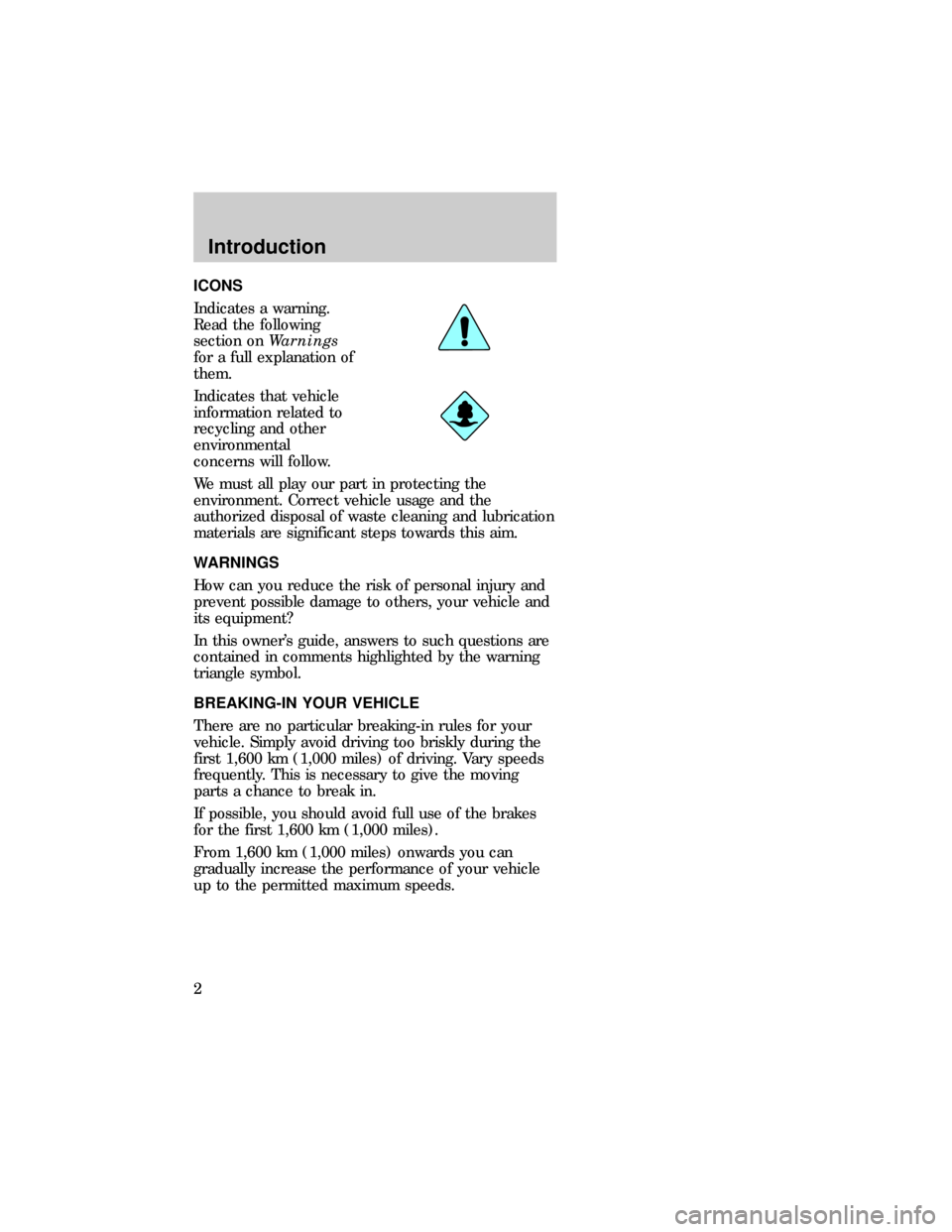
ICONS
Indicates a warning.
Read the following
section onWarnings
for a full explanation of
them.
Indicates that vehicle
information related to
recycling and other
environmental
concerns will follow.
We must all play our part in protecting the
environment. Correct vehicle usage and the
authorized disposal of waste cleaning and lubrication
materials are significant steps towards this aim.
WARNINGS
How can you reduce the risk of personal injury and
prevent possible damage to others, your vehicle and
its equipment?
In this owner's guide, answers to such questions are
contained in comments highlighted by the warning
triangle symbol.
BREAKING-IN YOUR VEHICLE
There are no particular breaking-in rules for your
vehicle. Simply avoid driving too briskly during the
first 1,600 km (1,000 miles) of driving. Vary speeds
frequently. This is necessary to give the moving
parts a chance to break in.
If possible, you should avoid full use of the brakes
for the first 1,600 km (1,000 miles).
From 1,600 km (1,000 miles) onwards you can
gradually increase the performance of your vehicle
up to the permitted maximum speeds.com_icons.01
com_warn.01
com_breaking_vehicle.01
com_info_guide.01
Introduction
2
Page 53 of 167
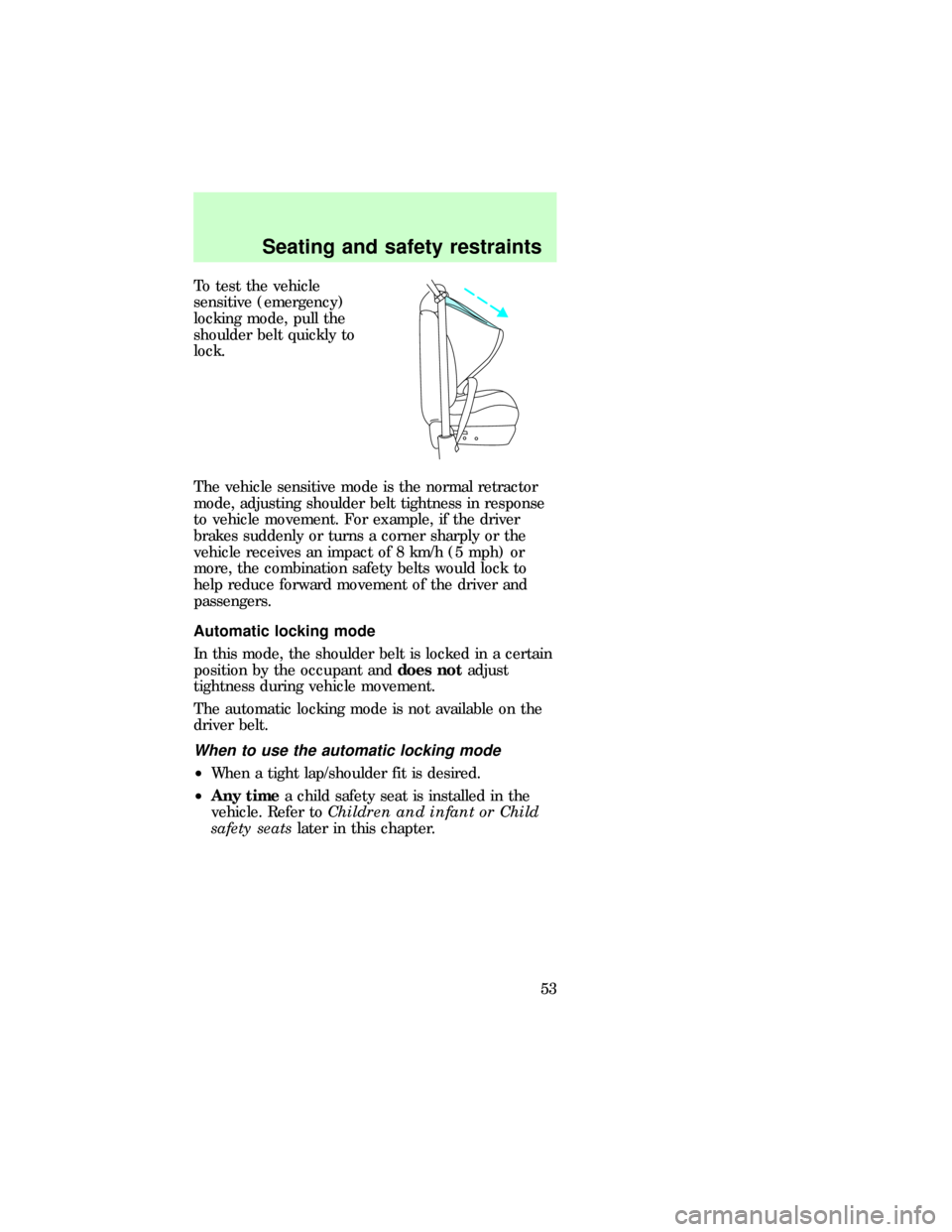
To test the vehicle
sensitive (emergency)
locking mode, pull the
shoulder belt quickly to
lock.
The vehicle sensitive mode is the normal retractor
mode, adjusting shoulder belt tightness in response
to vehicle movement. For example, if the driver
brakes suddenly or turns a corner sharply or the
vehicle receives an impact of 8 km/h (5 mph) or
more, the combination safety belts would lock to
help reduce forward movement of the driver and
passengers.
Automatic locking mode
In this mode, the shoulder belt is locked in a certain
position by the occupant anddoes notadjust
tightness during vehicle movement.
The automatic locking mode is not available on the
driver belt.
When to use the automatic locking mode
²When a tight lap/shoulder fit is desired.
²Any timea child safety seat is installed in the
vehicle. Refer toChildren and infant or Child
safety seatslater in this chapter.
dno_when-to-use-locking-mode
dno_how-to-use-locking-mode
Seating and safety restraints
53
Page 81 of 167
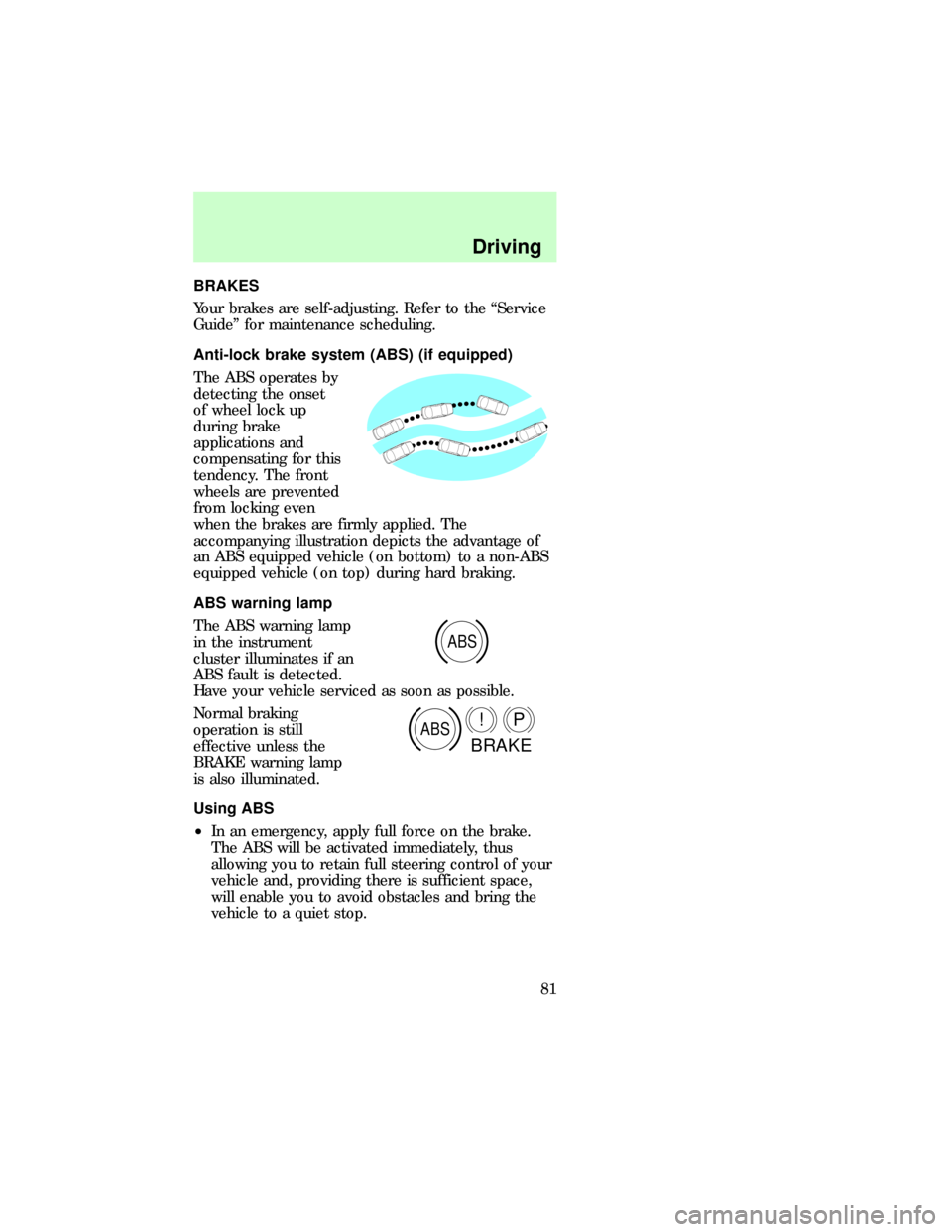
BRAKES
Your brakes are self-adjusting. Refer to the ªService
Guideº for maintenance scheduling.
Anti-lock brake system (ABS) (if equipped)
The ABS operates by
detecting the onset
of wheel lock up
during brake
applications and
compensating for this
tendency. The front
wheels are prevented
from locking even
when the brakes are firmly applied. The
accompanying illustration depicts the advantage of
an ABS equipped vehicle (on bottom) to a non-ABS
equipped vehicle (on top) during hard braking.
ABS warning lamp
The ABS warning lamp
in the instrument
cluster illuminates if an
ABS fault is detected.
Have your vehicle serviced as soon as possible.
Normal braking
operation is still
effective unless the
BRAKE warning lamp
is also illuminated.
Using ABS
²In an emergency, apply full force on the brake.
The ABS will be activated immediately, thus
allowing you to retain full steering control of your
vehicle and, providing there is sufficient space,
will enable you to avoid obstacles and bring the
vehicle to a quiet stop.
ABS
ABSP!
BRAKE
com_brakes.01
com_abs.01
dno_ABS-warning-light
com_using_abs.01
Driving
81
Page 82 of 167

²We recommend that you familiarize yourself with
this braking technique. However, avoid taking any
unnecessary risks.
Parking brake
The parking brake
should be used
whenever the vehicle is
parked. Push pedal
downward to set the
parking brake.
The BRAKE warning
lamp in the instrument
cluster illuminates and
remains illuminated
(when the ignition is turned ON) until the parking
brake is released.
Always set the parking brake fully and make
sure the gearshift is latched in P (Park).
Turn off the ignition whenever you leave your
vehicle.
The parking brake is not designed to stop a moving
vehicle. However, if the normal brakes fail, the
parking brake can be used to stop your vehicle in an
emergency. Since the parking brake applies only the
rear brakes, the vehicle's stopping distance will
increase greatly and the handling of your vehicle will
be adversely affected.
P!
BRAKE
dno_parking-brake
Driving
82
Page 83 of 167

Pull release handle
toward you to release
parking brake. Driving
with the parking brake
on will cause the
brakes to wear out
quickly and reduce fuel
economy.
TRANSAXLE
Brake-shift interlock
This vehicle is equipped with a brake-shift interlock
feature that prevents the gearshift from being moved
from P (Park) unless the brake pedal is pressed.
If you cannot move the gearshift out of P (Park)
with the brake pedal depressed:
1. Apply the parking brake, turn ignition key to
LOCK, then remove the key.
2. Insert the key and turn it to OFF. Apply the brake
pedal and shift to N (Neutral).
3. Start the vehicle.
If it is necessary to use the above procedure to
move the gearshift, it is possible that a fuse has
blown and the vehicle's brake lamps may not be
operating properly. Refer toFuses and relaysin the
Roadside emergencieschapter.
Do not drive your vehicle until you verify
that the brakelamps are working.
If your vehicle gets stuck in mud or snow it may be
rocked out by shifting from forward and reverse
gears in a steady pattern. Press lightly on the
dno_transaxle
dno_bsi
Driving
83
Page 91 of 167
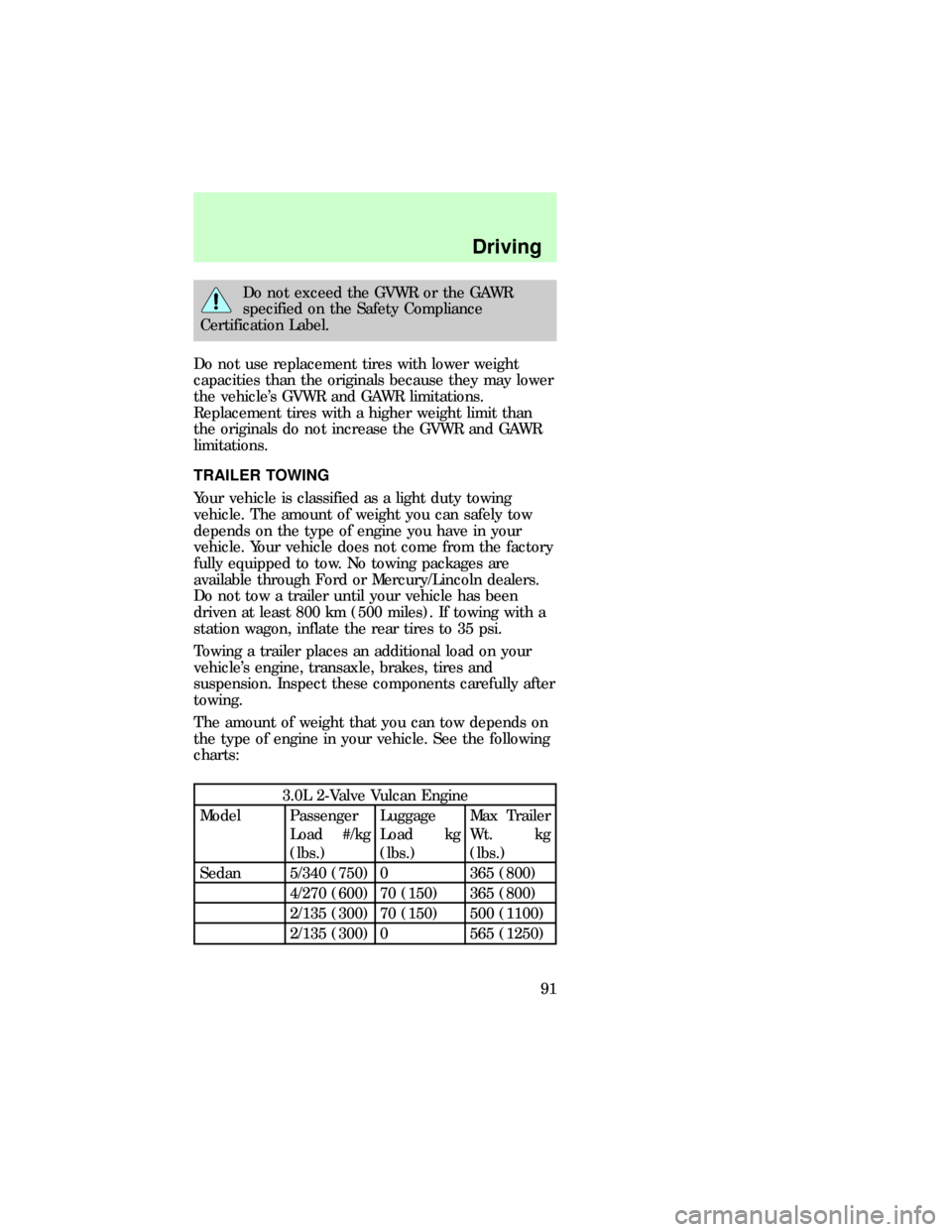
Do not exceed the GVWR or the GAWR
specified on the Safety Compliance
Certification Label.
Do not use replacement tires with lower weight
capacities than the originals because they may lower
the vehicle's GVWR and GAWR limitations.
Replacement tires with a higher weight limit than
the originals do not increase the GVWR and GAWR
limitations.
TRAILER TOWING
Your vehicle is classified as a light duty towing
vehicle. The amount of weight you can safely tow
depends on the type of engine you have in your
vehicle. Your vehicle does not come from the factory
fully equipped to tow. No towing packages are
available through Ford or Mercury/Lincoln dealers.
Do not tow a trailer until your vehicle has been
driven at least 800 km (500 miles). If towing with a
station wagon, inflate the rear tires to 35 psi.
Towing a trailer places an additional load on your
vehicle's engine, transaxle, brakes, tires and
suspension. Inspect these components carefully after
towing.
The amount of weight that you can tow depends on
the type of engine in your vehicle. See the following
charts:
3.0L 2-Valve Vulcan Engine
Model Passenger
Load #/kg
(lbs.)Luggage
Load kg
(lbs.)Max Trailer
Wt. kg
(lbs.)
Sedan 5/340 (750) 0 365 (800)
4/270 (600) 70 (150) 365 (800)
2/135 (300) 70 (150) 500 (1100)
2/135 (300) 0 565 (1250)
sab_trailer-towing
Driving
91
Page 93 of 167

Preparing to tow
Use the proper equipment for towing a trailer, and
make sure it is properly attached to your vehicle.
See your dealer or a reliable trailer dealer if you
require assistance.
Hitches
Your vehicle has a load carrying hitch. This type of
hitch places the tongue load of a trailer on the rear
wheels of your vehicle. You must distribute the load
in your trailer so that 10±15% of the total weight of
the trailer is on the tongue.
Safety chains
Always connect the trailer's safety chains to the
vehicle. To connect the trailer's safety chains, cross
the chains under the trailer tongue and allow slack
for turning corners.
If your use a rental trailer, follow the instructions
that the rental agency gives to you.
Trailer brakes
Electric brakes and manual, automatic or surge-type
brakes are safe if installed properly and adjust them
to the manufacturer's specifications. The trailer
brakes must meet local and Federal regulations.
Do not connect a trailer's hydraulic brake
system directly to your vehicle's brake
system. Your vehicle may not have enough braking
power and your chances of having a collision
greatly increase.
Trailer lamps
Trailer lamps are required on most towed vehicles.
Make sure your trailer lamps conform to local and
Federal regulations. See your dealer or trailer rental
agency for proper instructions and equipment for
hooking up trailer lamps.
dno_driving-while-you-tow
Driving
93
Page 120 of 167
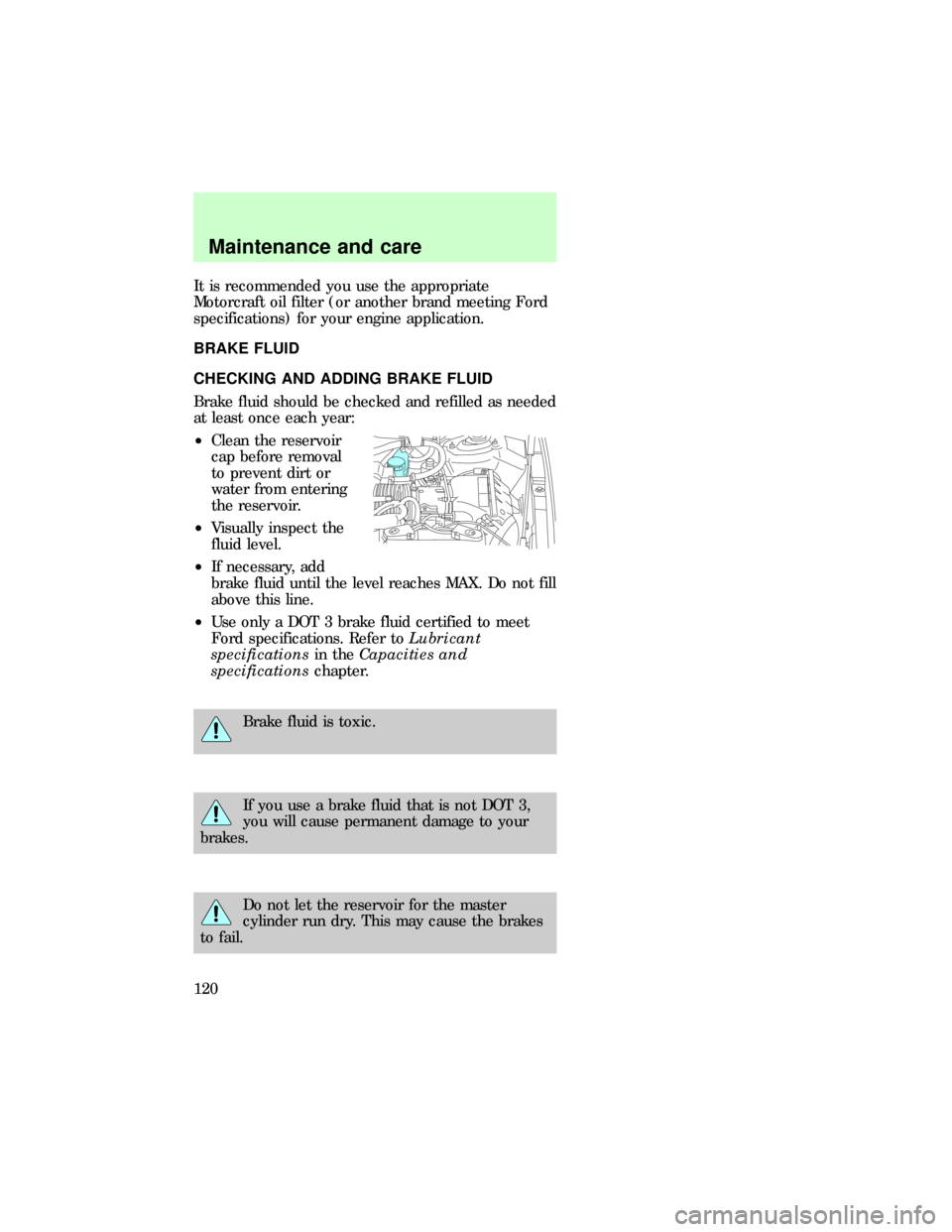
It is recommended you use the appropriate
Motorcraft oil filter (or another brand meeting Ford
specifications) for your engine application.
BRAKE FLUID
CHECKING AND ADDING BRAKE FLUID
Brake fluid should be checked and refilled as needed
at least once each year:
²Clean the reservoir
cap before removal
to prevent dirt or
water from entering
the reservoir.
²Visually inspect the
fluid level.
²If necessary, add
brake fluid until the level reaches MAX. Do not fill
above this line.
²Use only a DOT 3 brake fluid certified to meet
Ford specifications. Refer toLubricant
specificationsin theCapacities and
specificationschapter.
Brake fluid is toxic.
If you use a brake fluid that is not DOT 3,
you will cause permanent damage to your
brakes.
Do not let the reservoir for the master
cylinder run dry. This may cause the brakes
to fail.
dno_brake-fluids
com_checking-adding_fluid.01
dno_washer-fluid
Maintenance and care
120
Page 147 of 167

exterior accessories, such as antennas, before
entering a car wash.
²After washing, apply the brakes several times to
dry them.
Waxing your vehicle
The best way to determine when the paintwork
needs waxing is by noting when water stops beading
on the surface. This could be every three or four
months, depending on operating conditions.
Use only carnauba or synthetic-based waxes.
Remove any bugs and tar before waxing vehicle. Use
cleaning fluid or alcohol with a clean cloth to
remove. Use tar remover to remove any tar spots.
Repairing paint chips
Minor scratches or paint damage from road debris
may be repaired with touch-up paint, paint repair
foil or aerosol paint spray from the Ford accessory
line. Observe the application instructions on the
products.
Remove particles such as bird droppings, tree sap,
insect remains, tar spots, road salt and industrial
fallout immediately.
Cleaning the wheels
Wash the wheels with
the same detergent you
use to clean the body
of your vehicle. Do not
use acid-based wheel cleaners, steel wool, fuel or
strong detergents. Never use abrasives that will
damage the finish of special wheel surfaces. Use a
tar remover to remove grease and tar.
Cleaning the engine
Engines are more efficient when they are clean
because grease and dirt buildup act as insulators and
keep the engine warmer than normal. Follow these
guidelines to clean your engine:
com_waxing_vehicle.01
com_repairing_chips
com_wheels_cleaning.01
com_engine_cleaning.01
Maintenance and care
147
Page 163 of 167

Aiming headlamps .. 144
Air bag supplemental
restraint system
and child safety
seats ......................... 61
description .............. 60
disposal .................... 64
indicator light ......... 63
passenger air bag ... 62
Air cleaner filter
replacing ................ 129
Air conditioning
automatic temperature
control system 16,17,18,
19,20
manual heating and air
conditioning
system ........... 14,15,16
Anti-theft system ...... 44
warning light ............. 8
Audio system (see
Electronic sound
system) ...................... 21
Autolamp system (see
Headlamps) ............... 13
Battery ..................... 127
servicing ................ 128
Brakes
adjustment .............. 81
anti-lock ................... 81
fluid, checking and
adding .................... 120
Brake-shift interlock . 83
Break-in period ........... 2
Cargo cover ............... 35
Cargo net ................... 35
Child safety seats ...... 66
Childproof locks ........ 31
Cleaning your vehicle 146
built-in child seat . 150engine
compartment ......... 147
fabric ...................... 149
instrument panel .. 149
plastic parts .......... 148
safety belts ............ 150
tail lamps ............... 148
washing .................. 146
waxing ................... 147
wheels .................... 147
Climate control
system ........................ 14
Console, description . 31
Daytime running light
system ........................ 14
Emission control
system ...................... 137
Engine
service points . 116,117
Engine block heater . 79
Engine coolant
checking and
adding ............. 121,122
disposal .................. 123
refill capacities ...... 124
Engine oil ................ 119
changing oil and oil
filter ....................... 119
checking and
adding .................... 118
Entry system
illumination ............. 43
Exhaust fumes .......... 79
Floor mats ................. 33
Fuel
calculating fuel
economy ................ 137
improving fuel
economy .................. 95
octane rating ......... 136
Index
163